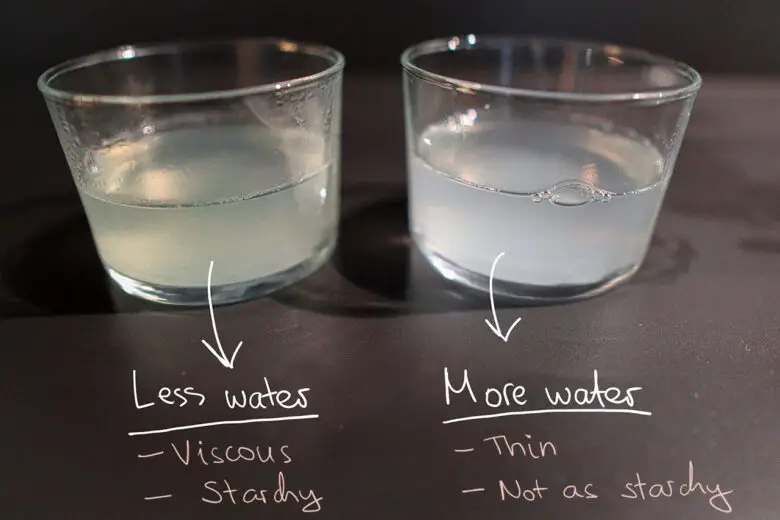The rule of thumb has always been to use plenty of water for pasta. But some are challenging this notion. Here’s why.
It’s easy to think that the only way to cook pasta is in a large pot of water. After all, it’s the way our parents did it, it’s how celebrity chefs do it on YouTube, and it’s the technique that cookbook authors tell us to use in our own kitchens.
But here’s the thing: You can actually cook pasta in less water than most recipes call for. And, in more than one way, doing so can help you make tastier pasta.
Let’s look at this in more detail and talk about why.
How Much Water Do You Really Need for Pasta?
Culinary tradition and lore tell us to use the 1:10 ratio: To get the right amount of water to use for pasta, in milliliters (ml), take the weight of the pasta in grams (g) and multiply it by 10.
For instance, you’d cook 100 g of pasta in 1,000 ml (1 liter) of water, 250 g of pasta in 2,500 ml (2.5 l), 450 g in 4,500 ml (4.5 l), and so on.
But do you really need this much?
To make a long story short, no. Perhaps that’s why many food writers have been challenging this notion.
You can cook pasta in as little water as you like, as long as the pasta is fully submerged in the water, which allows it to cook evenly.
When you use less water to cook pasta, the pasta will cook more slowly and the cooking water will become cloudier and milkier since there’s more starch per milliliter of liquid.
See for yourselves. I cooked two handfuls of pasta nests in two pots, one with more water and the other with less. (The pasta I used was Garofalo, a brand that ranks highly on our list of the best Italian pasta brands.)
Here’s a side-by-side comparison:

After cooking pasta in less water, the water turned yellower from the semolina flour and became thicker due to the higher starch content. In contrast, the water from the pot with more water was thinner, a bit whiter, and easier to see through.
Don’t stress too much about the pasta sticking together. Yes, the starchier water might make the noodles or shapes stick a bit more than usual. But you can easily prevent this by cooking the pasta at a rolling boil.
Why Cook Your Pasta in Less Water?
It’s really quite simple: When used to help make the sauce, thicker pasta water will result in a richer sauce.
If you plan to add some pasta water to your sauce, like in pasta carbonara or cacio e pepe, cooking the pasta in less water will make the water starchier and stickier, resulting in a tastier, creamier sauce.
This cooking technique will make a big difference in some dishes, where the pasta water is a key ingredient in the sauce, and less so in others.
Cooking pasta in less water is also convenient.
If you’re making a weeknight dinner for a small family, for example, it’s easier to fill and clean a medium-sized saucepan than it is to deal with a Dutch oven or pasta pentola.
For some, it’s also about saving the planet. Some American households use more than 100 gallons of water a year just to cook pasta, writes David Tamarkin at Epicurious. Can you even imagine the impact if everyone started boiling theirs in less water?
Would Your Italian Nonna Approve of This?
So, when it comes to Italian culinary tradition, just how acceptable is it to cook pasta in less water? Would it make the great Italian chefs of the past turn in their graves? Would your Italian grandma give it her approval?
As with many good questions, the answer is, it depends. In a sense, Italian pasta chefs do this—but with a twist.
For instance, in traditional Italian cooking, it’s not unusual to cook the pasta until it’s almost al dente, then move it from the pot to the saucepan and finish cooking it there for 1-2 minutes. Technically, when you finish cooking pasta in the sauce and thicken the sauce while the pasta cooks, you’re still cooking the pasta in less water… right?
But hey, it’s your kitchen, and no one’s judging. I’m sure not every Italian grandma makes carbonara like the late, great Antonio Carluccio, and I’m sure he would only smile and approve of it were he were still here with us today.
So give this pasta-cooking technique a try and stick with it if you like it.
Bringing It All Together
Yes, you can cook pasta in less water than most recipes suggest. It will make a noticeable difference in some recipes, less so in others. But either way, it’ll be quicker and more eco-friendly—so whether you do it or not it entirely up to you.
If you’re looking for my advice, give it a try and see for yourself. The worst that could happen is you end up with a plate of delicious pasta!
